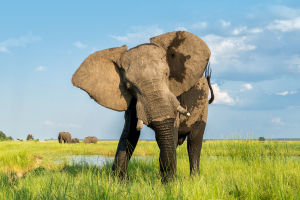Have you ever wondered what it’s like to meet the biggest bird in the world? Today, let's take a journey together to explore ostriches—these amazing giants who have roamed the earth since the Pleistocene era.
Living across Africa’s deserts and grassy savannas, ostriches have become true survival masters, thanks to their unique traits and strong adaptability. They are not just famous for their size, but also for their speed and fascinating lifestyle!
What Makes Ostriches So Unique?
When we talk about size, ostriches truly stand out. Adult males can grow up to 8.2 feet (2.5 meters) tall and weigh as much as 340 pounds (155 kilograms). Females are slightly smaller but still impressively large. Even though they can’t fly, their wings play an important role—they help keep balance while running, warm up their featherless thighs in cold weather, and even show off during mating season. Their wings also act as protective umbrellas for their young and eggs.
Unlike other birds, ostriches have two toes on each foot. This special design, especially the large toe that looks like a hoof, gives them incredible running power. Plus, their legs are long, slim, and powerful, helping them sprint at speeds up to 40 miles per hour (65 kilometers per hour)!
The Beauty in Their Details
Let’s take a closer look. Male ostriches are dressed in stunning black feathers with bright white tails, making them striking figures across the African plains. Their necks and legs often show shades of blue-gray or pink. During the breeding season, males show even stronger pink tones on their beaks, legs, and toes. Females, on the other hand, wear a more modest outfit of gray-brown feathers, blending well into the environment to protect their nests.
Ostriches also have huge eyes—the largest of any land animal. Each eye weighs about 2 ounces (60 grams) and gives them sharp vision up to 2 to 3 miles (3 to 5 kilometers) away. Their third eyelid, called a nictitating membrane, protects their eyes from dust and sand while they move around their dry habitats.
Growing Up Fast and Strong
Baby ostriches start life covered in fluffy yellow feathers with black tips. By around three months, they begin to replace this baby fluff with adult feathers. Male chicks start showing their black-and-white coloring after about eleven months. Ostriches grow fast, gaining strength and size to survive the tough environments they call home.
Daily Life of an Ostrich
Ostriches are true land explorers. They live in groups ranging from 5 to 50 members and often share their homes with other herbivores like zebras and antelopes. Life is all about movement, finding food, and staying safe.
Their diet mainly consists of grasses, shrubs, and green parts of plants, but they’re not picky. Sometimes, they munch on small insects like locusts and grasshoppers to boost their protein intake. In dry seasons, juicy plants help them stay hydrated. Despite being able to survive without drinking for long periods, ostriches love water and enjoy taking baths whenever they find a good spot.
One fun fact? Ostriches spend a lot of time pecking—anywhere between 2,000 to 4,000 times a day! It’s part feeding, part exploring their surroundings. However, this habit means we need to be careful when raising young ostriches in captivity so they don’t accidentally eat things that can upset their stomachs.
Nature’s Ultimate Sprinters
Ostriches’ legs are not just for show. These birds have evolved to escape predators with amazing speed and stamina. Their long, muscular legs allow them to run away from lions, cheetahs, and leopards—usually tiring the predators out before they can catch up.
They also have a clever way of staying aware of danger. Thanks to their sharp eyes and excellent vision, they can spot a threat from miles away, giving them plenty of time to react.
Why We Find Ostriches So Fascinating
Ostriches remind us of how animals adapt in brilliant ways to their environment. With their record-breaking speed, stunning looks, and smart survival skills, they are truly one of nature’s most fascinating wonders. Their powerful running legs, unique two-toed feet, and giant, expressive eyes all show just how incredible life on Earth can be.
Lykkers, have you ever imagined standing next to one of these amazing birds, looking into their huge eyes? Let’s keep our love for nature strong and discover even more wonderful creatures on this adventure together!
Watch these baby ostriches run! They're not too smart though
Video by NikelaWildlife


